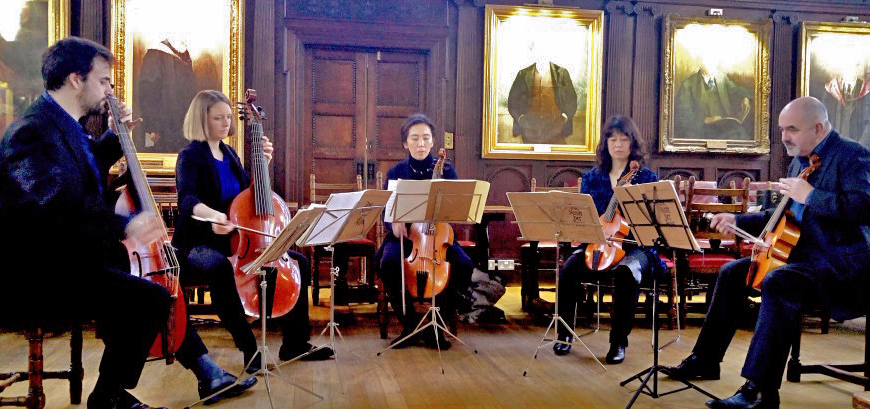Hottest Music of the 16th Century
Early Music Now presents Fretwork, which performs music that was once all the rage.
Fretwork, England’s favorite viol consort, returns to the Early Music Now series for the fourth time this Saturday evening at the UW-Milwaukee Zelazo Center.
Fretwork’s ensemble of five players, led by founder Richard Boothby, return to the music of their first album, produced in 1985 – exploring 15th and 16th century chamber works which emerged from one of the few genuine fads in the history of Western music, the “In Nomine.”
In the 16th century, John Taverner wrote a mass, in the tradition of Renaissance composition, incorporating a Medieval chant as the cantus firmus (central element, literally “fixed song”) in the work. The practice of the day: Start with a meditative melody originally meant to be sung in unison. Add voices above and below the melody which weave patterns, often at a faster pace, to elaborate on the sound. Fit the text of the Catholic mass to the vocal choir.
Yet the result was the creation of more than 300 such works which survive today. No longer sacred song, these instrumental miniatures are transformed from one version to another with entirely different effects. Some strive for the ethereal quality of the original. Others play with rhythms or the role of each part. You can vary the mood almost infinitely. An In Nomine by Christopher Tye imitates the criers on the street. One by Robert Parsons offers an aggressive, catchy pace. Henry Purcell expands the structure to its limits. His Fantasia Upon One Note weaves counterpoint around a part assigned a single note.
Youtube selections include many In Nomine examples, including those with scores or graphic representation. I’ve organized a listening set here.
In 1995, Fretwork commissioned 12 contemporary composers to write pieces for viol ensemble in the style of early works. The concert will include recent interpretations by Gavin Bryars and Nico Muhly. Boothby observes, “The composers are very happy to understand what the viol can do. Muhly had an understanding of the textures and the esthetic of the viol from his past as a choir boy in an American Anglican church.”
As a viol consort, Fretwork offers a unique aural experience. When the violin family replaced these early string instruments, a more precise, louder voice emerged. The extra strings (usually 6), larger body, frets and distinctly different bowing of the viol produce a rich, resonate sound. An ensemble of viols interacting together sound like a mellow organ. Boothby adds detail. “The frets make each stop note similar to an open string. The bloom around the sound is greater. Gut strings produce a less glassy sound than metal strings. There is a slight edge and roughness to them which gives each note its particular initial click which expresses the countrapuntal lines so well.”
The full name, viola da gamba, refers to the practice of holding each instrument between the knees in an upright position. The viol family, as a “chest” of six instruments were often played by amateurs in informal gatherings.
The In Nomine concert begins at 7:30 p.m. at the Helene Zelazo Center for the Performing Arts – 2419 E. Kenwood Blvd. A pretalk starts at 6:30 p.m. The program, notes and text may be found on-line. Tickets are $29 – $59; $10 – $20 for students. They may be purchased on-line or at 414-225-3113. Tickets are also available in full or partial season packages in three seating sections, with discounts for 4- 5- or 6-concert packages. Each full 6-concert subscription comes with a voucher for one free guest ticket.
Preview
-
A Sacred Choir, 70 Voices Strong
 Dec 14th, 2025 by Martha Brown
Dec 14th, 2025 by Martha Brown
-
Prometheus Trio Goes Bohemian
 Dec 3rd, 2025 by Martha Brown
Dec 3rd, 2025 by Martha Brown
-
Present Music Offers New Choral Works
 Nov 20th, 2025 by Michael Barndt
Nov 20th, 2025 by Michael Barndt






















I’m familiar with the work of John Taverner, and I can’t wait to see and hear this concert by Fretwork on Saturday night, Oct. 8th!